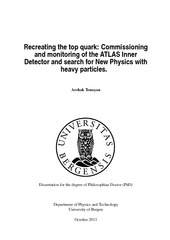| dc.contributor.author | Tonoyan, Arshak | eng |
| dc.date.accessioned | 2012-06-06T12:12:46Z | |
| dc.date.available | 2012-06-06T12:12:46Z | |
| dc.date.issued | 2012-02-03 | eng |
| dc.identifier.isbn | 978-82-308-1962-3 | en_US |
| dc.identifier.uri | https://hdl.handle.net/1956/5824 | |
| dc.description.abstract | The ATLAS (A Toroidal Lhc ApparatuS) experiment is one of the two general purpose experiments at the Large Hadron Collider (LHC) at CERN, the European Organization for Nuclear Research. The LHC is a proton-proton and ion-ion collider built in a 27 km long circular tunnel 100 meter below the surface of the Earth. The maximum energy at which LHC is capable to collide protons is 14 TeV in the center of mass frame, but currently it is being operated at half of its maximum energy, i.e. at 7 TeV. The first collisions at the LHC took place in November 2009. Before that the LHC detectors, including ATLAS (which was already built and installed in 2007) were commissioned using muons produced from the interaction of cosmic rays with the Earth atmosphere. The Inner Detector is one of components of ATLAS detector, which is responsible for tracking of charged particles. It consists of three independent but complementary sub-detectors, which are built using different types of charged particle detecting concepts. This thesis is based on four papers. The first paper documents the first measurement of the top quark charge at the LHC. The analysis is done on the data collected by ATLAS in the first half of year 2011. The charge is measured with two different techniques and the results from both show that the top quark charge is in agreement with the Standard Model (SM) prediction. The second paper is actually a book, written by collaborative efforts of almost all members of the ATLAS collaboration, describing the status of all the analyses before the launch of the LHC. I have contributed in two chapters of this book with performing simulation based analyses of the top quark charge measurement and estimating the possibility to observe supersymmetric signals with help of tau leptons. The third paper concerns the search for physics beyond the Standard Model. Several extensions of the Standard Model predict the existence of extra gauge bosons heavy enough to decay to top-antitop pairs. The studies based on the simulation of the production of such particles with different masses are performed in order to evaluate the potential of the ATLAS detector to discover them if they exist. The last paper summarizes the results of the commissioning of the reconstruction software for the ATLAS detector with cosmic muons and with the data from the first proton-proton collisions at the LHC. As a part of ATLAS reconstruction software, the Inner Detector Global Monitoring tool was also commissioned. | en_US |
| dc.language.iso | eng | eng |
| dc.publisher | The University of Bergen | en_US |
| dc.relation.haspart | Paper I: The ATLAS Collaboration, Measurement of the top quark charge in pp collisions at √s = 7 TeV in the ATLAS experiment, ATLAS-CONF-2011-141, Sep. 2011. . Full text not available in BORA. | en_US |
| dc.relation.haspart | Paper II: The ATLAS Collaboration, Expected performance of the ATLAS experiment: detector, trigger and physics, chapters "Top Quark Properties", and "Measurements from Supersymmetric Events", CERN-OPEN-2008-020, CERN, Geneva, 2009. Full text not available in BORA. | en_US |
| dc.relation.haspart | Paper III: E. Khramov, A. Tonoyan, V. Bednyakov and N. Rusakovich, On the Possibility of the Search for Top–Antitop Resonances at the LHC. Physics of Particles and Nuclei Letters, Volume 5(6): 515-519, January 2008. Full text not available in BORA due to publisher restrictions. The article is available at: <a href="http://dx.doi.org/10.1134/S1547477108060058" target="blank"> http://dx.doi.org/10.1134/S1547477108060058</a> | en_US |
| dc.relation.haspart | Paper IV: A. Tonoyan, M.J. Costa and J.T. Boyd on behalf of the ATLAS Collaboration, Commissioning of the ATLAS reconstruction software with first data. Journal of Physics: Conference Series 219 032059, 2010. Full text not available in BORA due to publisher restrictions. The article is available at: <a href="http://dx.doi.org/10.1088/1742-6596/219/3/032059" target="blank"> http://dx.doi.org/10.1088/1742-6596/219/3/032059</a> | en_US |
| dc.title | Recreating the top quark: Commissioning and monitoring of the ATLAS Inner Detector and search for New Physics with heavy particles. | en_US |
| dc.type | Doctoral thesis | |
| dc.rights.holder | Copyright the author. All rights reserved | en_US |
| dc.subject.nsi | VDP::Mathematics and natural science: 400::Physics: 430 | en_US |
